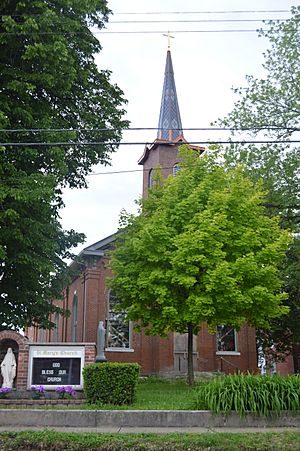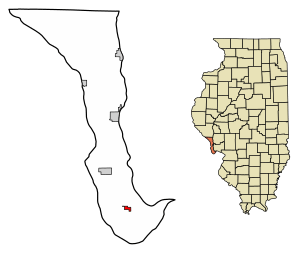Brussels, Illinois facts for kids
Quick facts for kids
Brussels
|
|
|---|---|

St. Mary's Catholic Church, May 2014
|
|

Location of Brussels in Calhoun County, Illinois.
|
|

Location of Illinois in the United States
|
|
| Country | United States |
| State | Illinois |
| County | Calhoun |
| Area | |
| • Total | 0.558 sq mi (1.45 km2) |
| • Land | 0.558 sq mi (1.45 km2) |
| • Water | 0.00 sq mi (0 km2) |
| Elevation | 515 ft (157 m) |
| Population
(2020)
|
|
| • Total | 116 |
| • Density | 207.9/sq mi (80.3/km2) |
| Time zone | UTC-6 (CST) |
| • Summer (DST) | UTC-5 (CDT) |
| Area code(s) | 618 |
| FIPS code | 17-09148 |
| GNIS feature ID | 2397479 |
| Wikimedia Commons | Brussels, Illinois |
Brussels is a small village located in the southern part of Calhoun County, in the state of Illinois, United States. In 2020, about 116 people lived there.
Contents
About Brussels, Illinois
Brussels is home to the main office of the Two Rivers National Wildlife Refuge. This refuge is a special place known for its many bald eagles. It gets its name because two very large rivers, the Illinois River and the Mississippi River, meet nearby.
Schools in Brussels
Brussels has its own school district, called No. 42. This district includes two schools:
- Brussels Grade School (for younger students)
- Brussels High School (for older students)
These schools also serve students from nearby communities like Meppen, Golden Eagle, and parts of Batchtown. Besides the public schools, Brussels also has a private school called St. Marys Grade School. Brussels High School is quite small, usually having around 70 students.
History of Brussels
Brussels was first settled in 1822 by John Mettz. Later that same year, Joshua Twitchell opened the village's first business, a blacksmith shop.
Growth and New Settlers
The village grew a lot in 1843 when many German immigrants moved to the area. More German families arrived through the 1860s. In the 1850s, Irish immigrants also began to settle in Brussels.
Early Businesses and Churches
- In 1847, the Wittmond Trading Post opened. This was one of the first brick stores in the entire region, and it helped Brussels become a center for business.
- St. Mary's Church was started in 1848 for the village's Catholic residents. The church building you see today was built in 1863.
- In the early 1860s, St. Matthew's Church was formed for the German Lutheran people living in Brussels.
Becoming an Official Village
Brussels continued to develop:
- It opened its own post office in 1875.
- A village jail was built in 1876.
- In 1888, Brussels officially became an incorporated village.
Today, the main street of Brussels is recognized as a historic district. It is even listed on the National Register of Historic Places, which means it's a special place with important history.
Geography of Brussels
Brussels is located at 38°56′50″N 90°35′19″W / 38.94722°N 90.58861°W.
The village covers a total area of about 0.56 square miles (1.45 square kilometers). All of this area is land.
Population Changes Over Time
The number of people living in Brussels has changed over the years:
| Historical population | |||
|---|---|---|---|
| Census | Pop. | %± | |
| 1890 | 228 | — | |
| 1900 | 270 | 18.4% | |
| 1910 | 283 | 4.8% | |
| 1920 | 280 | −1.1% | |
| 1930 | 279 | −0.4% | |
| 1940 | 275 | −1.4% | |
| 1950 | 205 | −25.5% | |
| 1960 | 201 | −2.0% | |
| 1970 | 191 | −5.0% | |
| 1980 | 168 | −12.0% | |
| 1990 | 125 | −25.6% | |
| 2000 | 141 | 12.8% | |
| 2010 | 141 | 0.0% | |
| 2020 | 116 | −17.7% | |
| U.S. Decennial Census | |||
People in Brussels (Demographics)
Based on the 2020 census, there were 116 people living in Brussels. These people made up 36 households, with 17 of them being families.
Who Lives Here?
- Most residents (about 94%) were White.
- A small number were African American (less than 1%) or from other races (about 1.7%).
- About 3.5% of the population identified as being from two or more races.
- About 1.7% of the people were Hispanic or Latino.
Households and Families
- About 11% of households had children under 18 living with them.
- Almost 44.5% were married couples living together.
- About 52.8% of all households were made up of individuals living alone.
- About 19.4% of households had someone aged 65 or older living by themselves.
Age Groups
The ages of people in Brussels were spread out like this:
- About 9.7% were under 18 years old.
- About 6.2% were between 18 and 24 years old.
- About 30.1% were between 25 and 44 years old.
- About 34.5% were between 45 and 64 years old.
- About 19.5% were 65 years old or older.
The average age in the village was about 48.5 years.
Education
The local school district for Brussels is called Brussels Community Unit School District 42.
See also
 In Spanish: Brussels (Illinois) para niños
In Spanish: Brussels (Illinois) para niños

